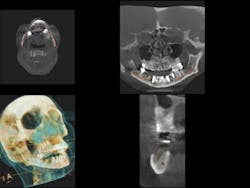Identifying EFS from the outset
By Joseph J. Massad, DDS
For more on this topic, go to www.dentaleconomics.com and search using the following key words: functional space, esthetic prosthesis, occlusion, implant, crest, Dr. Joe Massad.
Welcome back! This month's tip involves determining the space between the facial draping in reference to the edentulous alveolar ridge. This space – referred to as the esthetic functional space (EFS) – is vital in determining the specific treatment plan for the desired implant prosthesis. The determination of the need for preprosthetic surgery may narrow patient options on bar designs, stud type abutments, fixed dentures, or implant fixed bridge restorations.
I have consulted with hundreds of dentists who, at one time, had an undesirable result due to not identifying EFS from the onset and informing patients of the possible limitations of the type of prosthesis which would best suit their particular situations.
The solution to this problem is to simply measure this space with the esthetic functional lip ruler (gdit.us). Figure 1a shows the esthetic functional ruler (EFLR) for measuring in millimeters both the maxillary and mandibular ridge crest to resting lip. Figure 1b shows the stops that rest on the ridge crest. Figure 2a shows a patient displaying excess show of mandibular teeth and occlusal plane discrepancy. Figure 2b demonstrates EFLR measurement of 17 mm from the resting lower lip to the premandibular crest. Figure 3a denotes five implants and a cast metal bar frame. Figure 3b measures the height of the bar from the ridge crest to the top of the bar. Figure 4a shows 9 mm of tooth exposed above the lower lip. Figure 4b demonstrates the height of the mandibular prosthesis attached to the bar measuring 26 mm.
In this example, it would be necessary for the dentist to consider, instead of a bar attachment, utilizing a stud attachment, allowing the prosthesis to be fabricated at a lower height to conform to the lower lip edge. An overall height of 17 mm for the final restoration would be optimal. This would also allow an appropriate plane of occlusion. The EFLR can be utilized for both the maxillary and mandibular measurements, avoiding situations violating the various esthetic functional spaces on your patients.
The simplicity of this ruler allows the practitioner the ability to diagnose the maxillary and mandibular esthetic functional space at the time of examination. This also allows the practitioner to discuss with the patients appropriate options or limitations, which improves communication about the overall treatment options.
I hope this tip will help you as it has helped me over my career. To view the full video step-by-step version, go to www.dentistryiq.com.
See you next month.I hope my pleasure in dentistry will also be yours...Joe Massad.
Dr. Joseph Massad may be reached by phone at (918) 749-5600 or by e-mail at [email protected].
To see Dr. Massad's video tips, visit www.dentistryIQ.com

